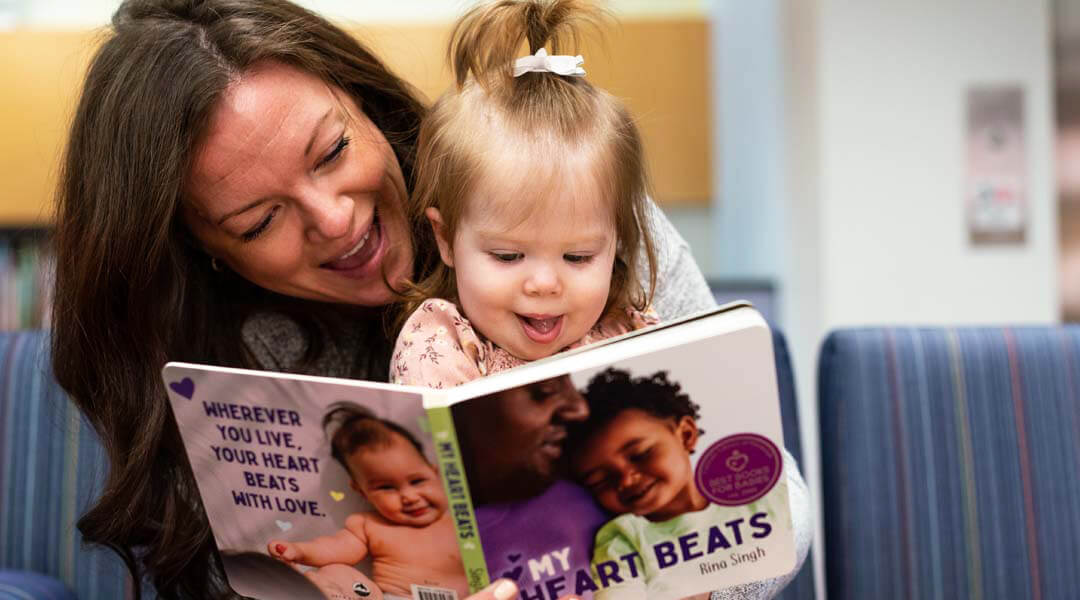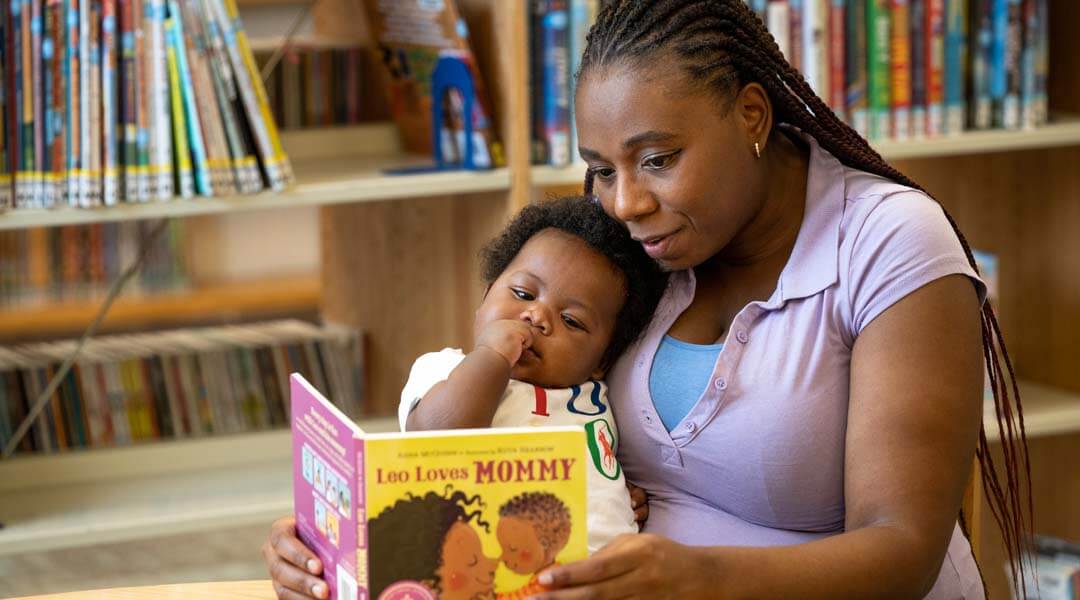Because of you, parents, teachers and caregivers have access to quality reading materials to share with babies from birth to 18 months.
Every new parent’s mind is filled with questions: What type of diapers should I use? What crib is best? Which stroller? And, what should I read to my newborn? Thanks to your support, the Library can help you with that last question.
Babies love books. Cuddling up with a caregiver, looking at pictures and listening to the rhythm of words (whether they understand them or not) can be comforting, exciting or just plain fun.
“One of my favorite things to hear about is how babies become the ‘readers’ themselves over time,” says Carnegie Library of Pittsburgh’s Coordinator of Children’s Services & Family Engagement Erin Zambataro. “We love to have moms, dads and aunties tell us how their child responds without prompting, repeating favorite words or phrases. Last week, a grandmother sent a video of her baby turning the pages while they read together. Grandma was beaming. She was so proud.”
The idea of curating a list of Best Books for Babies began in 2000, initiated by Beginning with Books codirectors Dr. Betty Segel and Dr. Joan Friedberg. Joining forces with University of Pittsburgh Professor Dr. Margaret Mary Kimmel, the trio landed on a singular idea: launch a committee that would select and recommend page-turners for babies up to the age of 18 months, igniting a passion for literacy at an early age. When the nonprofit closed in 2010, the Library took over the Best Books for Babies program, recommitted to its mission statement and went to work. The list is now nationally recognized.
“There are a lot of different aspects of a book that go into making it a great book for babies,” says Lisa Dennis, the Library’s Coordinator of Children’s and Teen Collections and an original member of the committee who has served continuously for 23 years. “One is the format. We are looking for books that are durable, easy to hold and manipulate, and maybe include tactile elements or interactive features like flaps or tabs. We also look for books that have familiar, age-appropriate subjects or themes. We want babies and their caregivers to be able to relate to the content. That might include photos of babies, which babies love to look at, simple stories about family members and everyday life or ‘point and say’ books that will eventually help to develop vocabulary.”
They’re also looking for quality. “Things like skillfully implemented rhythm and rhyme; clear, uncluttered illustrations; and diverse and authentic representation of race, gender, ability, culture and family structure,” Lisa adds. But the most important component is the adult who is sharing the book. “We always suggest that folks read books they like and enjoy, otherwise reading becomes a chore for everyone involved.”

The process for choosing the ten books that ultimately land on the Best Books for Babies annual booklist begins with the committee, a dynamic group that includes librarians, a children’s author/illustrator, parents, pediatricians and other childcare professionals.
Choosing a winning title doesn’t happen with the flip of a coin. Contenders for the annual list are whittled down from around 100 to 200 potential books. And while the program doesn’t have a controlled focus group of babies who give the yay or nay to a contending title, there are consistent hits that tend to get their stamp of approval.
“Books with bold, black and white and sometimes red contrast are best for newborns because they are easy for their young eyes to focus on,” says Erin, who serves alongside Lisa as Co-Chair of the Best Books for Babies Committee. “I have lots of stories about parents who are shocked when their infants home in on a black and white book from the list and become enthralled. These books are also a favorite for tummy time readings.”
Setting aside even just a few minutes a day to read to your baby sets them up for success. It also reinforces the idea that reading is not only important but enjoyable, too.
“The first three years of brain development are critical. The more words children hear, the more the speech and language parts of their brains are stimulated,” says Erin. Even so, parents and caregivers shouldn’t stress about the how, when or where of reading to their baby. “It’s perfectly fine to read only a few pages. There’s no rule that you have to read a book from beginning to end in one sitting. I recommend creating a predictable routine at naptime or bedtime, but it can also be fun to be spontaneous and pick up a book to read anytime. Reading to your baby beginning at birth really helps to prepare them for learning to read in kindergarten and a lifetime of reading and learning.”
Thank you! Your generosity supports the importance of reading and helps start children on the path to educational success.
The Library’s Best Books for Babies initiative is intended to encourage reading beginning at birth and recognize publishers who create excellent books for the very youngest listeners. The annual booklist can be found at bestbooksforbabies.org.

